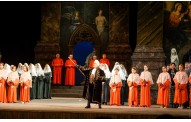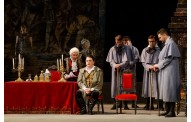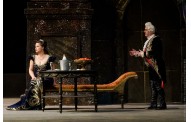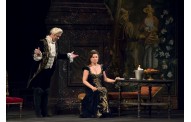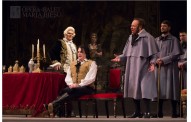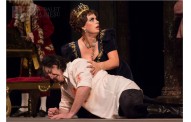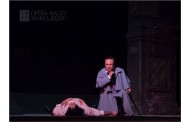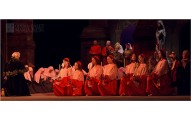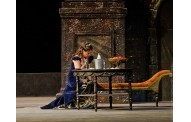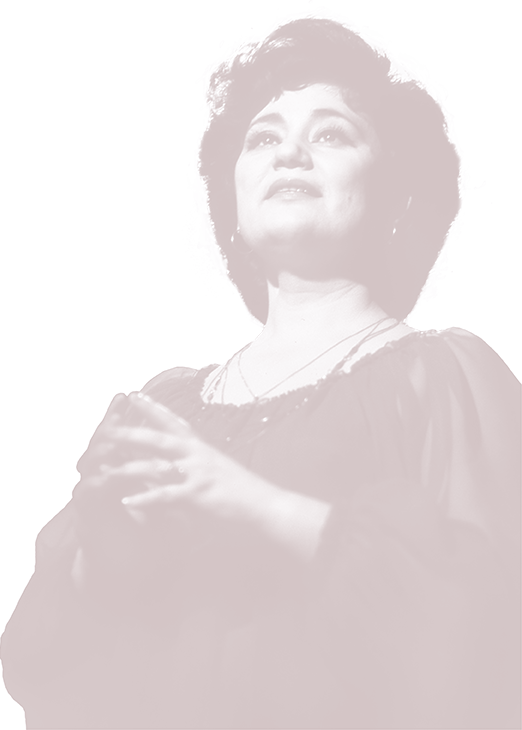
ACT I
The church of Sant'Andrea della Valle, Rome, June 1800.
Cesare Angelotti, an escaped political prisoner, rushes into the church. His sister has hidden the key to the Attavanti family chapel at the foot of the statue of the Blessed Virgin. After some difficulty, he finds it, and hides in the chapel just as the busybody Sacristan enters. The Sacristan sourly comments on having to clean brushes for Cavaradossi, an artist who is painting a portrait of Mary Magdalene in the church. At the sound of the Angelus, the Sacristan kneels to pray. He is interrupted by Cavaradossi, who has returned to work on the portrait, the model for which is a beautiful unknown woman who has been praying in the church daily. Under the Sacristan's disapproving eye, Cavaradossi works on the painting, contrasting the beauty of the blonde, blue-eyed Magdalene with that of the woman he loves, the raven-haired singer Floria Tosca ("Recondita armonia.") The Sacristan shuffles out, appeased by the prospect of eating Cavaradossi's untouched supper later on.
Angelotti ventures out. Cavaradossi doesn't recognize him at first, for his imprisonment has changed him greatly. Angelotti was once the Consul of the overthrown Roman Republic. He tells Cavaradossi of his escape, and Cavaradossi vows to help him. But Angelotti must hide again as Tosca is heard calling outside. Cavaradossi hurries him into the chapel, and gives him the supper basket.
Cavaradossi goes to let Tosca into the church. She jealously questions him about his delay in answering the door. She heard him talking to someone, and accuses him of meeting another woman there. She softens when he tries to kiss her, reminding him that they are in church. She prays to the Blessed Virgin, and then seductively reminds him of their tryst that night. Worried about Angelotti, he tries to get her to leave, which raises her suspicions again. And then she sees the blonde woman in the portrait. Recognizing the likeness of the Marchesa Attavanti in the painting, she explodes with renewed suspicions, but Cavaradossi tenderly reassures her, over and over, of his fidelity. She is at last convinced . . . but she wants him to change the color of the eyes to black.
When Tosca finally leaves, Cavaradossi summons Angelotti, and explains that he couldn't share his secret with Tosca because she places too much faith in her confessor. Angelotti isn't sure whether he ought to leave the country or stay hidden in Rome. His sister -- the Marchesa Attavanti -- has hidden a dress, a veil, and a fan in the chapel so Angelotti can disguise himself as a woman. Cavaradossi now realizes that the unknown praying him whom he used as a model for the portrait is none other than the Marchesa. Angelotti explains that she would do anything to keep him out of the clutches of Baron Scarpia, the evil chief of the secret police. Cavaradossi once again vows to help; Angelotti can hide in his country villa. Angelotti gets the bundle of clothes his sister left him, but leaves behind the fan. When a cannon shot signals that the police have discovered Angelotti's escape, the two rush off to the villa.
The Sacristan returns with a group of choirboys who are to sing a Te Deum in celebration of the reported retreat of Napoleon's troops. Their excitement is silenced by the entrance of Scarpia and his agents, who are in search of Angelotti. Scarpia questions the trembling Sacristan about the Attavanti chapel. The poor man is astounded to find it unlocked by a second key. Scarpia, pleased with this clue, enters the chapel and finds the fan, which has the Attavanti crest on it. Then he recognizes the Marchesa in the portrait. The Sacristan tells him that Cavaradossi painted the portrait. Scarpia ponders the connection: Cavaradossi is Tosca's lover, and also a political dissident . . . The Sacristan interrupts his train of thought, babbling that he has found Cavaradossi's empty supper basket in the chapel. He can't imagine how it happened, for Cavaradossi didn't have a key to the chapel, and he said he wasn't hungry . . . Now all is clear to Scarpia. Angelotti must have eaten the food.
Tosca comes back looking for Cavaradossi. Scarpia plans to make her jealous by showing her the Marchesa's fan. She is already suspicious thanks to the Sacristan's news that Cavaradossi has unexpectedly left. Scarpia takes this opportunity to greet her gallantly and insinuate that Cavaradossi has had a tryst with the Marchesa. When she demands proof, he shows her the fan, claiming that he found it on the painter's scaffold. Believing Cavaradossi to be faithless, Tosca tearfully vows vengeance and leaves as the church resounds with the Te Deum. Scarpia orders his men to tail her. He is ecstatic, for he plans to have Tosca for himself ("Va, Tosca!").
ACT II
Scarpia's apartments in the Palazzo Farnese, later that night.
Scarpia enjoys his dinner, anticipating the pleasure of seeing Angelotti and Cavaradossi hanged. He tells his minion, Sciarrone, to bring a note to Tosca asking her to come see him. He vows to bend Tosca to his will ("Ha piu forte sapore.")
His assistant, Spoletta, arrives and reports that he and other agents followed Tosca to a country villa. She went inside, but came out again right away. He and the agents scoured the property for Angelotti, but found only Cavaradossi, whom they arrested. Through the window, Tosca and a choir can be heard singing at a royal gala downstairs. Cavaradossi is brought in for questioning, but he denies all knowledge of Angelotti's whereabouts.
Tosca enters as her lover is being taken to an adjoining room for torture. Unnerved by Scarpia's insistent questioning and Cavaradossi's screams, she finally reveals Angelotti's hiding place, in a well in the garden of Cavaradossi's villa. The torture stops. Cavaradossi is carried in, swooning. Tosca rushes to him, and lies when he asks her if she revealed anything. But Scarpia tells Spoletta to go to the well in the garden. Realizing what has happened, Cavaradossi rages at Tosca. Then Sciarrone rushes in to announce that Napoleon has won the Battle of Marengo, a defeat for Scarpia's side. Cavaradossi shouts his defiance ("Vittoria!") and is carried off to prison.
Tosca, forced to remain with Scarpia, asks him, "How much?" But he is not to be bought for money . . . And now he reveals his desire for her, made more passionate by the sight of her tears. He tries to embrace her. Tosca, horrified, tries to get away from him. Realizing that she intends to appeal to the Queen, he lets her pass, but reminds her that the Queen cannot pardon a corpse. Seeing the contempt in her look, he becomes even more excited, and tries again to embrace her. Her cries for help inflame him even more. Then a slow drum roll is heard. It is the signal for an impending execution. Cavaradossi has just one hour to live . . . Tosca asks God why this is happening to her, for she has always had faith, and has dedicated her life to art and love ("Vissi d'arte").
Tosca then begs Scarpia, on her knees, to spare Cavaradossi. But Scarpia will do so only if she gives herself to him. Tosca gets up, disgusted. Then Spoletta interrupts: faced with capture, Angelotti has killed himself. And everything is ready for Cavaradossi's execution. Tosca, forced to decide, agrees to Scarpia's proposition. Scarpia pretends to order a mock firing squad execution for Cavaradossi, after which he is to be free. Spoletta leaves to make the preparations.
At Tosca's insistence, Scarpia prepares a safe-conduct for the lovers so they can leave the country. As he writes it out, Tosca goes to the dinner-table to take a glass of wine. Then she sees a knife . . . Scarpia, safe-conduct in hand, tries to embrace her. Tosca suddenly stabs him in the chest and taunts him as he bleeds to death. She wrenches the safe-conduct from his stiffening hand and, placing candles at his head and a crucifix on his chest, slips quietly out.
ACT III
The parapet of the Castel Sant'Angelo, early the next morning.
In the distance, a young shepherd sings a sorrowful love-song. Church bells toll the dawn as a jailer prepares for Cavaradossi's execution. Cavaradossi arrives and bribes the sympathetic jailer with a ring to let him write a farewell note to Tosca. As he writes, he is overcome with memories of love, and gives way to despair ("E lucevan le stelle").
Suddenly Tosca runs in and excitedly tells him what she has done. Cavaradossi caresses the hands that committed the murder for his sake ("O dolci mani,") and the two hail their future freedom.
Tosca then coaches Cavaradossi on how to fake his death convincingly. After another tender love scene, the firing squad arrives at last. Tosca watches, admiring her lover's acting skill. The soldiers fire; Cavaradossi falls; the soldiers depart. Tosca waits until it is safe, then urges Cavaradossi to hurry. But when he fails to move, she realizes that Scarpia has betrayed her in the end: the bullets were real.
As she wails in despair, Spoletta rushes in to arrest her for Scarpia's murder. But she climbs the battlements and, crying out that she will meet Scarpia before God, leaps to her death.
Conductor:
Libretto: Luigi Illica şi Giuseppe Giacosa
based on French-language dramatic play "La Tosca" by Victor Sardou
Stage Director: Eugen Platon, People`s Artist
Set Designer: Veaceslav Ocunev
Costume Designer: Irina Press, Master of Arts
Coordinating Director: Simone Frediani
First Choir Master: Oleg Constantinov, People's Artist
World Premiere: January 14, 1900, la Teatro di Constanzza, Rome.
Premiere in Chisinau: April 28, 1962, at Moldavian State Theatre of Opera and Ballet.
Premiere of the current version: May 21, 1989, at State Academic Opera and Ballet Theatre.
Running time: 2 hours 30 min (two intervals)
Opera is presented in Italian
Subtitles in Romanian

